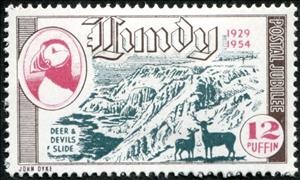Stamp: Deer and Devil´s Slide (Cinderellas 1954)
Deer and Devil´s Slide (Cinderellas 1954)
01 January (Cinderellas ) within release Lundy goes into circulation Stamp Deer and Devil´s Slide face value 12 Lundy puffin
| Stamp Deer and Devil´s Slide in catalogues | |
|---|---|
| Colnect codes: | Col: LU 1954-07 |
Stamp is square format.
Designed by John Dyke, inscribed 1929-1954Also in the issue Lundy:
- Stamp - Pictures of Lundy and Puffin face value ½;
- Stamp - Pictures of Lundy and Puffin face value 1;
- Stamp - Pictures of Lundy and Puffin face value 2;
- Stamp - Pictures of Lundy and Puffin face value 4;
- Stamp - Aviation with date face value ½;
- Stamp - Aviation with date face value 1;
- Stamp - Aviation with date face value 2;
- Stamp - Aviation without date face value ½;
- Stamp - Aviation without date face value 1;
- Stamp - Aviation without date face value 2;
- Stamp - Millenary face value ½;
- Stamp - Millenary face value ½;
- Stamp - Millenary face value 1;
- Stamp - Millenary face value 1;
- Stamp - Millenary face value 2;
- Stamp - Millenary face value 2;
- Stamp - Millenary face value 3;
- Stamp - Millenary face value 3;
- Stamp - Bristol Brabazon face value 12;
- Stamp - Deer and Devil´s Slide face value 12;
- Stamp - Soay Sheep and Old Lighthouse face value 6;
- Stamp - Bristol 173 Helicopter face value 6;
- Stamp - Constable Rock face value 9;
- Stamp - De Haviland Comet Jet Plane face value 3;
- Stamp - Bristol 173 Helicopter face value 6;
- Stamp - De Haviland Comet Jet Plane face value 3;
- Stamp - Bristol Brabazon face value 12;
Stamp Deer and Devil´s Slide it reflects the thematic directions:
Animals are multicellular, eukaryotic organisms of the kingdom Animalia (also called Metazoa). All animals are motile, meaning they can move spontaneously and independently, at some point in their lives. Their body plan eventually becomes fixed as they develop, although some undergo a process of metamorphosis later on in their lives. All animals are heterotrophs: they must ingest other organisms or their products for sustenance.
Birds (Aves), a subgroup of Reptiles, are the last living examples of Dinosaurs. They are a group of endothermic vertebrates, characterised by feathers, toothless beaked jaws, the laying of hard-shelled eggs, a high metabolic rate, a four-chambered heart, and a strong yet lightweight skeleton. Birds live worldwide and range in size from the 5 cm (2 in) bee hummingbird to the 2.75 m (9 ft) ostrich. They rank as the class of tetrapods with the most living species, at approximately ten thousand, with more than half of these being passerines, sometimes known as perching birds. Birds are the closest living relatives of crocodilians.
Mammals are any vertebrates within the class Mammalia (/məˈmeɪli.ə/ from Latin mamma "breast"), a clade of endothermic amniotes distinguished from reptiles (including birds) by the possession of a neocortex (a region of the brain), hair, three middle ear bones and mammary glands. All female mammals nurse their young with milk, secreted from the mammary glands. Mammals include the largest animals on the planet, the great whales. The basic body type is a terrestrial quadruped, but some mammals are adapted for life at sea, in the air, in trees, underground or on two legs. The largest group of mammals, the placentals, have a placenta, which enables the feeding of the fetus during gestation. Mammals range in size from the 30–40 mm (1.2–1.6 in) bumblebee bat to the 30-meter (98 ft) blue whale. With the exception of the five species of monotreme (egg-laying mammals), all modern mammals give birth to live young. Most mammals, including the six most species-rich orders, belong to the placental group. The largest orders are the rodents, bats and Soricomorpha (shrews and allies). The next three biggest orders, depending on the biological classification scheme used, are the Primates (apes and monkeys), the Cetartiodactyla (whales and even-toed ungulates), and the Carnivora (cats, dogs, seals, and allies).
In geology, rock (or stone) is any naturally occurring solid mass or aggregate of minerals or mineraloid matter. It is categorized by the minerals included, its chemical composition, and the way in which it is formed. Rocks form the Earth's outer solid layer, the crust, and most of its interior, except for the liquid outer core and pockets of magma in the asthenosphere. The study of rocks involves multiple subdisciplines of geology, including petrology and mineralogy. It may be limited to rocks found on Earth, or it may include planetary geology that studies the rocks of other celestial objects.




